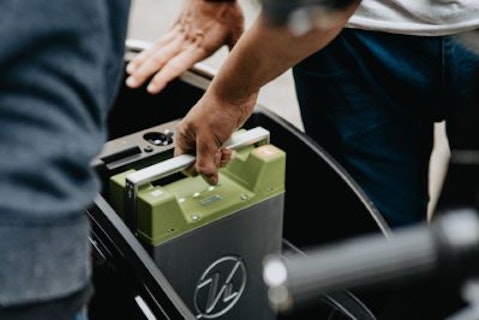In this article, we will look at 6 cheap solid-state battery stocks to buy. If you want to skip our detailed analysis of the solid-state battery market and explore similar stocks, you can also take a look at 3 Cheap Solid State Battery Stocks to Buy.
The lithium-ion batteries commonly utilized in smartphones and electric vehicles (EVs) currently available in the market are predominantly liquid-state batteries. These batteries employ a liquid electrolyte solution to facilitate the movement of ions between the cathode (positive) and anode (negative), resulting in the generation of electrical potential. In contrast, solid-state batteries, as implied by their name, eliminate the liquid electrolyte and substitute it with a solid material such as ceramics or glass. This shift to a solid substance enables the functioning of the battery. According to a research report by Allied Market Research, the global solid-state battery market size was valued at $0.5 billion in 2020, and is projected to reach $3.4 billion by 2030, growing at a CAGR of 18% from 2021 to 2030.
The advantages of solid-state batteries are twofold. Firstly, they offer enhanced safety compared to liquid-state batteries, which are susceptible to hazardous failures when damaged. Secondly, and of significant importance to electric vehicle (EV) manufacturers, removing the liquid component from batteries allows for increased electrical generation capacity. The technology has achieved significant advancement in recent years.
This battery technology has also caught the eye of the U.S. government and the aviation industry. This past year, NASA’s Solid-state Architecture Batteries for Enhanced Rechargeability and Safety (SABERS) team successfully developed a high-performing solid-state battery with the potential to store ample electricity and discharge it rapidly, making it a promising candidate for efficiently powering electric aircraft. Regarding this breakthrough, Rocco Viggiano, principal investigator for SABERS at NASA’s Glenn Research Center made the following remarks:
“We’re starting to approach this new frontier of battery research that could do so much more than lithium-ion batteries can. Not only does this design eliminate 30 to 40 percent of the battery’s weight, it also allows us to double or even triple the energy it can store, far exceeding the capabilities of lithium-ion batteries that are considered to be state of the art ”
Toyota Motor Corporation (NYSE:TM), the automotive giant, has made significant strides in solid-state battery technology, proclaiming a “technological breakthrough” that could revolutionize the range capabilities of their electric vehicles (EVs). According to Toyota’s assertions, advancements in aerodynamics, design, and battery technology will enable their EVs to travel over twice the distance of current models, covering a remarkable 1,200 kilometers on a single charge. Additionally, they anticipate a quick recharge time of 10 minutes or less. The company plans to introduce these advancements to the market between 2027 and 2028, aiming for a commercial rollout. They further express optimism that ongoing research could extend the cruising range even further, reaching an impressive 1,500 kilometers on a single charge. By comparison, the long-range version of the Tesla Model 3 currently offers a range of 602 kilometers.
While relatively new and emerging compared to conventional lithium-ion batteries, solid-state batteries are set to generate hefty profits if the aforementioned developments are anything to go by. This becomes more evident when we factor the various ambitious goals that certain EV makers have set for themselves. General Motors Company (NYSE:GM) has set an ambitious target to manufacture 1 million electric vehicles annually by 2025. Similarly, Ford Motor Company (NYSE:F) aims to produce 2 million electric vehicles per year by 2026. Meanwhile, Volkswagen’s vision is even bolder, aiming for 80% of EV sales in Europe and 55% in the U.S. by 2030.

Photo by Kumpan Electric on Unsplash
Our Methodology
For our list of cheap solid-state battery stocks to buy, we shortlisted 6 stocks that are either directly involved in the solid-state batteries, or are set to benefit from the technology’s growth. We made use of the Finviz stock screener to list down stocks that have P/E ratios less than 20 (as of July 25). Typically, the average P/E ratio is around 20 to 25. Anything below that would be considered a good price-to-earnings ratio, whereas anything above that would be a worse P/E ratio. Data from around 943 elite hedge funds tracked by Insider Monkey in the first quarter of 2023 was used to identify the number of hedge funds that hold stakes in each firm.
You have to keep in mind that this is an emerging technology, and it may be completely replaced by a superior technology at a future point, or abandoned in favor of the current lithium-ion batteries. Even though we present cheap solid-state battery stocks to buy in this article, they may not be the best stocks to buy in the market or the automotive industry. For more information on automotive industry, check out our article on the best car stocks to buy here.
6. Toyota Motor Corporation (NYSE:TM)
P/E ratio as of 25 July: 12.92
Number of Hedge Fund Investors: 7
Toyota Motor Corporation (NYSE:TM) is a Japanese multinational automotive manufacturer headquartered in Toyota City, Aichi, Japan, that owns notable brands such as Lexus, Ranz, Hino, and Daihatsu. Toyota Motor Corporation (NYSE:TM) also holds the title of the largest Japanese car company in terms of revenue, boasting an impressive $266.6 billion in earnings. Furthermore, the company’s industrial equipment sales, particularly forklifts, experienced significant growth, surging by 25% to reach $12.9 billion. In addition, the car manufacturer contributes 11.5% share of the world’s annual automobile output.
Earlier this month, the company made a significant announcement regarding its breakthrough in solid-state EV battery technology. By streamlining the production of materials used in solid-state batteries, Toyota Motor Corporation (NYSE:TM) intends to introduce a model by 2025 that will enhance cruising range by 20%. Additionally, the company is actively researching and developing a higher-performance version, which has the potential to achieve a 50% increase in cruising range, offering over 900 miles on a single charge. The company expects to be able to manufacture solid-state batteries for use in electric vehicles as soon as 2027.
At the close of the first quarter of 2023, 7 hedge funds reported holding stakes within Toyota Motor Corporation (NYSE:TM), compared to 10 in the previous quarter. Peter S. Stamos’ Stamos Capital is a notable shareholder of the company, with stakes worth roughly $2.58 million
Similar to General Motors Company (NYSE:GM) and Ford Motor Company (NYSE:F), Toyota Motor Corporation (NYSE:TM) is a company that investors should keep tabs on.
5. Honda Motor Company Ltd. (NYSE:HMC)
P/E ratio as of 25 July: 11.54
Number of Hedge Fund Investors: 11
Honda Motor Company Ltd. (NYSE:HMC) is a Japanese public multinational conglomerate manufacturer of automobiles, motorcycles, and power equipment, headquartered in Minato, Tokyo, Japan. Since 1959 it has been the top-selling motorcycle company in the world. In 2021, Honda Motor Company Ltd. (NYSE:HMC) set a goal to make only EVs or vehicles powered by hydrogen fuel cells by 2040. In 2022, it announced further plans to produce 2 million EVs and roll out 30 electric models by 2030.
Although the company was slow to embrace electric vehicles, similar to its Japanese peers, Honda Motor Company Ltd. (NYSE:HMC) has made several large bets to get ahead of the competition within this growing market, especially in the realm of EV batteries. This past year, the company announced a partnership with South Korean battery maker LG Energy Solution, Ltd. to build a $4.4 billion EV battery plant in the United States. Additionally, the company stated that it would dedicate $310 million to launch a pilot production line that produced all-solid-state batteries, further cementing its place within the market.
According to Insider Monkey’s first quarter database, 11 hedge funds were bullish on Honda Motor Company Ltd. (NYSE:HMC), with collective stakes worth $16.59 million, compared to 12 hedge funds in the previous quarter. Of these, Ken Griffin’s Citadel Investment Group is the leading shareholder, with stakes worth $5.86 million
4. Stellantis N.V. (NYSE:STLA)
P/E ratio as of 25 July: 3.11
Number of Hedge Fund Investors: 27
Stellantis N.V. (NYSE:STLA) emerged as a multinational automotive manufacturing corporation in 2021, resulting from a 50-50 cross-border merger between two prominent entities: the Italian-American conglomerate Fiat Chrysler Automobiles and the French PSA Group. One of the biggest automotive manufacturers in the world, its portfolio includes the likes of Alfa Romeo, Fiat, and Dodge.
This past year, Stellantis N.V. (NYSE:STLA) made an investment in Factorial Energy through its affiliate, participating in Factorial’s Series D funding round alongside other investors. The funding received will be utilized to expedite the commercial production and deployment of Factorial’s solid-state battery technology. During its EV Day program in July 2021, Stellantis N.V. (NYSE:STLA) announced its target of having the first competitive solid-state battery technology introduced by 2026.
Insider Monkey dug through 943 hedge funds for their March quarter of 2023 shareholdings to find out that 27 had held a stake in the firm. Stellantis N.V. (NYSE:STLA)’s largest hedge fund investor is Peter Rathjens, Bruce Clarke, and John Campbell’s Arrowstreet Capital through a stake of $598 million.
Stellantis N.V. (NYSE:STLA) stands out as not only an affordable solid-state battery stock but also one of the finest, alongside General Motors Company (NYSE:GM) and Ford Motor Company (NYSE:F).
Click to continue reading and see 3 Cheap Solid State Battery Stocks to Buy
Suggested Articles:
- Kevin O’Leary’s Stock Portfolio: 10 Stock Picks for 2023
- 10 AI Stocks Billionaires are Loading Up On
- 10 Tech Stocks Benefiting From The AI Boom
Disclosure: None. 6 Cheap Solid State Battery Stocks to Buy is originally published on Insider Monkey.





